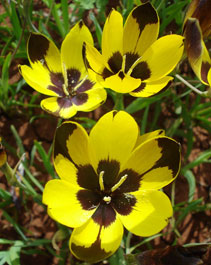Hesperantha vaginata
Hesperantha vaginata (Sweet) Goldblatt
Family: Iridaceae
Common names: harlequin evening flower (Eng.); harlekynaandblom, perdeblom (Afr.)
Introduction
The bright yellow flowers of Hesperantha vaginata, with their distinctive dark brown markings, have formed a very close evolutionary relationship with the monkey beetle Clania glenlyonensis.

Description
Description
Hesperantha vaginata is a geophyte, 120-180 mm high. The bright yellow flowers, 25-35 mm across, are large, cup-shaped, odourless and nectarless and often have contrasting dark brown markings. On days that are warm enough they will open from mid- to late afternoon. It has slightly fleshy, sword-shaped leaves and a small fibre-covered corm with a flattened base.

Conservation Status
Status
Hesperantha vaginata is endemic to the Bokkeveld Plateau and listed on the Red Data species list as Vulnerable, mainly due to land transformation (farming).
Distribution and habitat
Distribution description
Hesperantha vaginata is found on the Bokkeveld Plateau, up to Calvinia, on heavy clay soils derived from dolorite.
Derivation of name and historical aspects
History
The genus name Hesperantha comes from the Greek words hesperos meaning evening and anthos meaning flower. The epithet vaginata is derived from the Latin vagina = a sheath or covering, and refers to the leaves sheathing the stem.
Ecology
Ecology
H. vaginata is pollinated by a specialised monkey beetle, the hopline scarab beetle, Clania glenlyonensis. Beetle markings (dark spots and centres on the flower) attract pollinating monkey beetles. In some areas monkey beetles prefer flowers with dark beetle markings over flowers that have no markings.

Monkey beetles use the flowers as mating sites and also feed on the pollen.
Growing Hesperantha vaginata
Grow
Sow the seed in rich, well-drained soil in autumn. The soil pH should be mildly acidic (6.1 to 6.5) or neutral (6.6 to 7.5). H. vaginata is drought-tolerant and has average water needs. Do not overwater. Sow or plant in full sun to partial shade. It is also suitable for growing in containers. Flowering time is August to September.
In its native habitat it forms colonies in heavy clay soils, though it also thrives in a well-drained sandy mix.
Hesperantha is dormant in summer; so, no summer watering is wanted!
Allow the pods to dry on the plant and break open to collect seeds.
References
- Du Plessis, N. & Duncan, G. 1989. Bulbous plants of southern Africa. Tafelberg Publishers, Cape Town.
- Manning, J. & Goldblatt, P. 1997. Nieuwoudtville, Bokkeveld Plateau and Hantam. South African Wild Flower Guide 9. Botanical Society of South Africa, Cape Town. Goldblatt, P. & Manning, J.C. 2000. Iridaceae. In: Seed plants of southern Africa (ed. O.A. Leistner). Strelitzia 10. National Botanical Institute, Pretoria.
- http://plantlust.com/plants/hesperantha-vaginata/
- http://www.jstor.org/pss.3298575
- http://aob.oxfordjournals.org/content/100/7/1483.short
Credits
Colleen Rust
Hantam National Botanical Garden
October 2011
Plant Attributes:
Plant Type: Bulb
SA Distribution: Northern Cape
Soil type: Clay
Flowering season: Winter
PH: Acid, Neutral
Flower colour: Brown, Yellow
Aspect: Full Sun
Gardening skill: Challenging
Special Features:
Horticultural zones








Rate this article
Article well written and informative
Rate this plant
Is this an interesting plant?
Login to add your Comment
Back to topNot registered yet? Click here to register.